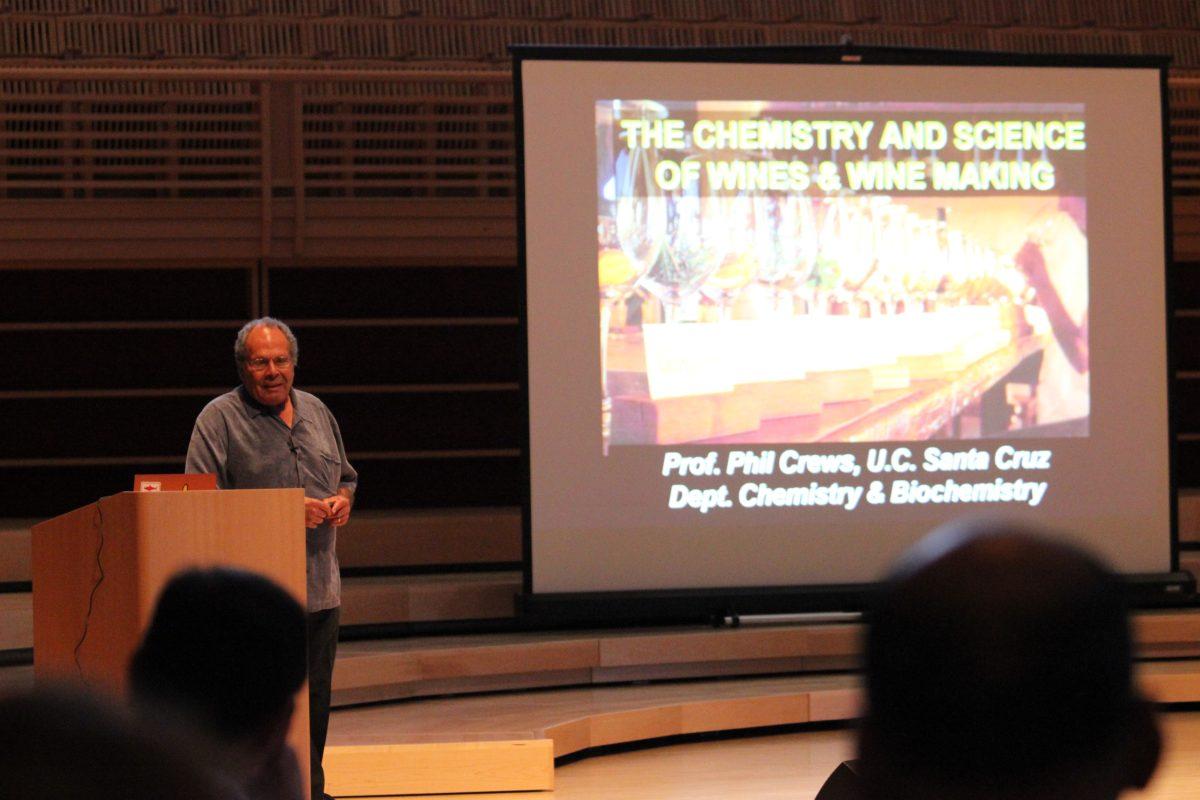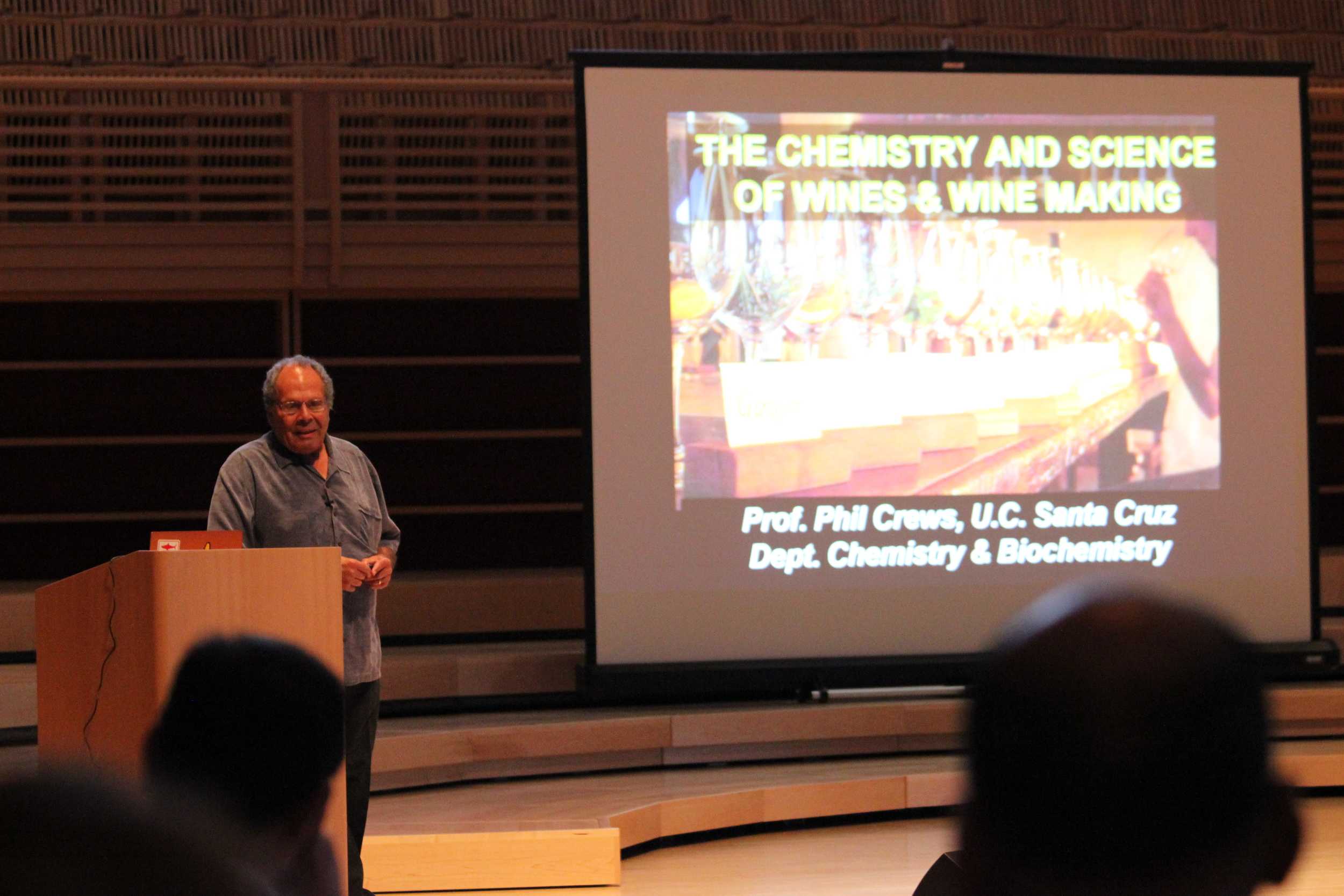The continuum of high-culture music concerts at Weill Hall was given a hiatus on April 17 for an introspective look inside the scientific soul of California winemaking. Chemistry and biochemistry professor Phil Crews from the University of California, Santa Cruz presented a lecture entitled “The Chemistry and Science of Wines & Wine Making” to more than 700 attendees consisting of Sonoma State chemistry and biochemistry students and faculty, curious enophiles and a few insiders from the local wine industry. The event was funded by a grant from the Green Music Center Board of Advisors University Affairs Committee.
Crews teaches “Intro to Wine & Wine Chemistry” and other courses at UC Santa Cruz and is the owner-winemaker of Pelican Ranch Winery in Capitola. His passion for science and winemaking, as well as his teaching experience, were clearly evident in his informal yet intellectual rhetorical style. Crews accompanied his lecture with a PowerPoint presentation as he wove a mosaic of winemaking basics, wine and grape chemistry, insight into ratings from wine competitions and critics and humorous observations about wine appreciation. He also offered advice on how to pursue a career in winemaking.
“The best way to start a winemaking journey is to get a chemistry degree, read scholarly books about winemaking, and finally, make and taste a lot of wine,” said Crews.
He introduced part two of his lecture, “Important Wine Molecules,” by saying 500 volatile compounds such as terpenes (aromatic hydrocarbons found in grapes and oak barrels) have been identified in white wines. For example, wine lactone (C10H14O2) leaves impressions of coconut on the human palate and can be detected at a threshold of only 0.01 micrograms per liter. He transitioned to the chemistry of wine by percentage of its components.
“Wine is approximately 86 percent water, 12 percent alcohol, one percent glycerol, .4 percent organic acids and .2 percent minerals such as calcium, magnesium and potassium,” said Crews in conjunction with PowerPoint slides showing graphs and lists. The audience laughed in unison as he made light of the fact that one could fulfill their recommended daily allowance of potassium by drinking a half-liter of wine daily.
Part three was titled “Importance of Sensory Evaluation.” This section included two suggested home experiments. One is an informal wine judging where the host places four wines in unmarked paper bags, and asks a group of 10 friends to rate the wines per the following system: “+” for the best wine, “–” for the worst wine, and “zero” for the remaining two wines. The host tallies the scores and announces the winners and losers.
On a more scientific note, Crews had data and charts comparing and contrasting the human sensory evaluation of wine with analysis via gas chromatography olfactometry (GC-O). The latter provided considerable depth and precision compared to human testing, but the human evaluation was nearly as accurate on most of the essential components. Crews did not qualify the experience of the human testers, but the data suggests they were trained professionals such as winemakers, sommeliers or wine critics.
During part four of his lecture, “The Grapes of Math v. the Grapes of Tradition,” Crews compared wines made with one controversial high-tech method versus traditional means. “The Grapes of Math” was the title of an article in the November 2001 issue of Wired magazine featuring Leo McCloskey’s biochemical company called Enologix. McCloskey created a database of benchmark wines by analyzing hundreds of critically acclaimed wines with biochemistry and computer software.
Enologix analyzes grapes before harvest and unfinished wines for its winery clients, and can advise them on the optimum time to pick the fruit as well as a variety of cellar practices such as fermentation temperatures, barrel selection, aging and filtering.
The goal is for clients to make wines that garner scores of 90+ points from publications such as Wine Advocate or Wine Spectator. Such esteem helps wineries “pull” their products through the sales and distribution channels.
Crews contrasted that approach with traditional winemaking methodology such as using native yeasts, simple barrel fermentations and unfiltered wines He prefers purchased strains of yeast instead of native yeasts and finishes all of his wines at Pelican Ranch Winery with screw cap closures because he believes they age his wines more consistently than cork.
Returning to advice for want-to-be winemakers, Crews listed several bastions of formal wine education such as the University of California, Davis; Fresno State University; Cornell University and more.
Crews finished his presentation with questions and answers, but not before one final jab at modern winemaking styles. “Buttery, oaky chardonnays are for termites.”





![[Both photos courtesy of sonoma.edu]
Ming-Ting Mike Lee stepped in as the new SSU president following Sakakis resignation in July 2022](https://sonomastatestar.com/wp-content/uploads/2024/04/CC4520AB-22A7-41B2-9F6F-2A2D5F76A28C-1200x1200.jpeg)



























